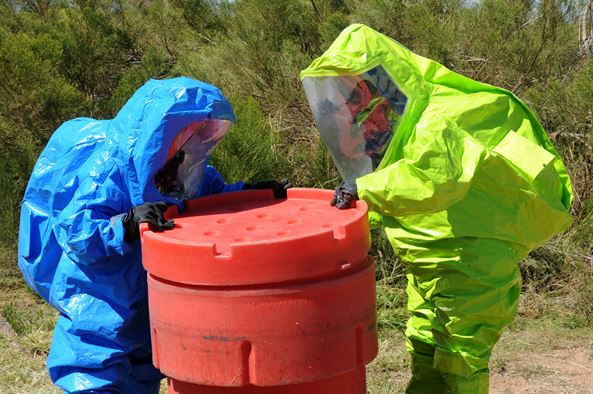Are You Covered by HAZWOPER?
OSHA's HAZWOPER standard covers all employers performing the following five general categories of work operations per 29 CFR 1910.120(a)(1)(i-v):
- Cleanup operations required by a governmental body, whether Federal, state local or other involving hazardous substances that are conducted at uncontrolled hazardous waste sites;
- Corrective actions involving cleanup operations at sites covered by the Resource Conservation and Recovery Act of 1976 (RCRA);
- Voluntary cleanup operations at sites recognized by Federal, state, local or other governmental bodies as uncontrolled hazardous waste sites;
- Treatment, storage, and disposal (TSD) facilities: Operations involving hazardous waste operations [paragraph (p)] (e.g., landfill that accepts hazardous waste), and
- Emergency response operations involving hazardous substance releases [paragraph (q)] (e.g., chemical spill at a manufacturing plant).
The HAZWOPER standard for the construction industry, 29 CFR 1926.65, is identical to 29 CFR 1910.120. For brevity, we reference 1910.120 for the HAZWOPER standard in this course.
Cleanup Operations
The employer involved in cleaning up, handling, or processing hazardous substances at a hazardous waste site, must comply with all parts of HAZWOPER except 1910.120 (p) and (q).
Cleanup operations involve employees who remove, contain, incinerate, neutralize, stabilize, process, or handle hazardous substances at a hazardous waste site to make it safe for people or the environment.
There are three kinds of cleanup operations:
- cleanup operations required by a government agency at an uncontrolled hazardous waste site,
- corrective actions that involve cleanup at sites covered by RCRA, and
- voluntary cleanup operations.
"Voluntary" means a government agency recognizes that a site contains hazardous substances that may pose a safety or health threat to workers or the environment until it is controlled.
These operations include those hazardous substance operations under the Comprehensive Environmental Response, Compensation, and Liability Act of 1980 as amended (CERCLA), including initial investigations at CERCLA sites before the presence or absence of hazardous substances has been determined.
Examples of types of uncontrolled hazardous waste sites that would be covered by HAZWOPER include those:
- Listed or proposed for listing on the National Priority List (NPL),
- Listed or proposed for listing on a State priority list,
- Identified or listed by a governmental agency as an uncontrolled hazardous waste site (Note: this includes voluntary cleanup operations), and
- Regulated as a corrective action covered by the Resource Conservation and Recovery Act (RCRA).
TSD Facilities
TSD facilities treat, store, or dispose of hazardous waste and are required to have an RCRA permit or interim status from EPA. If the TSD employer/facility has a RCRA permit or interim status, the employer must implement the following programs:
- safety and health program
- medical surveillance program
- decontamination program
- new technology program
- material handling program
- training program
- emergency response program
Other areas of a facility not covered by permit or interim status that could have uncontrolled releases of hazardous substances must develop a formal emergency response plan.
Employers who will evacuate their employees from the danger area when an emergency occurs, and who do not permit any of their employees to assist in handling the emergency, are exempt from the requirements of an emergency response plan if they provide an emergency action plan per 29 CFR 1910.38.
Knowledge Check Choose the best answer for the question.
1-10. Employers involved in cleaning up, handling, or processing hazardous substances at a hazardous waste site must comply with _____.
You forgot to answer the question!

